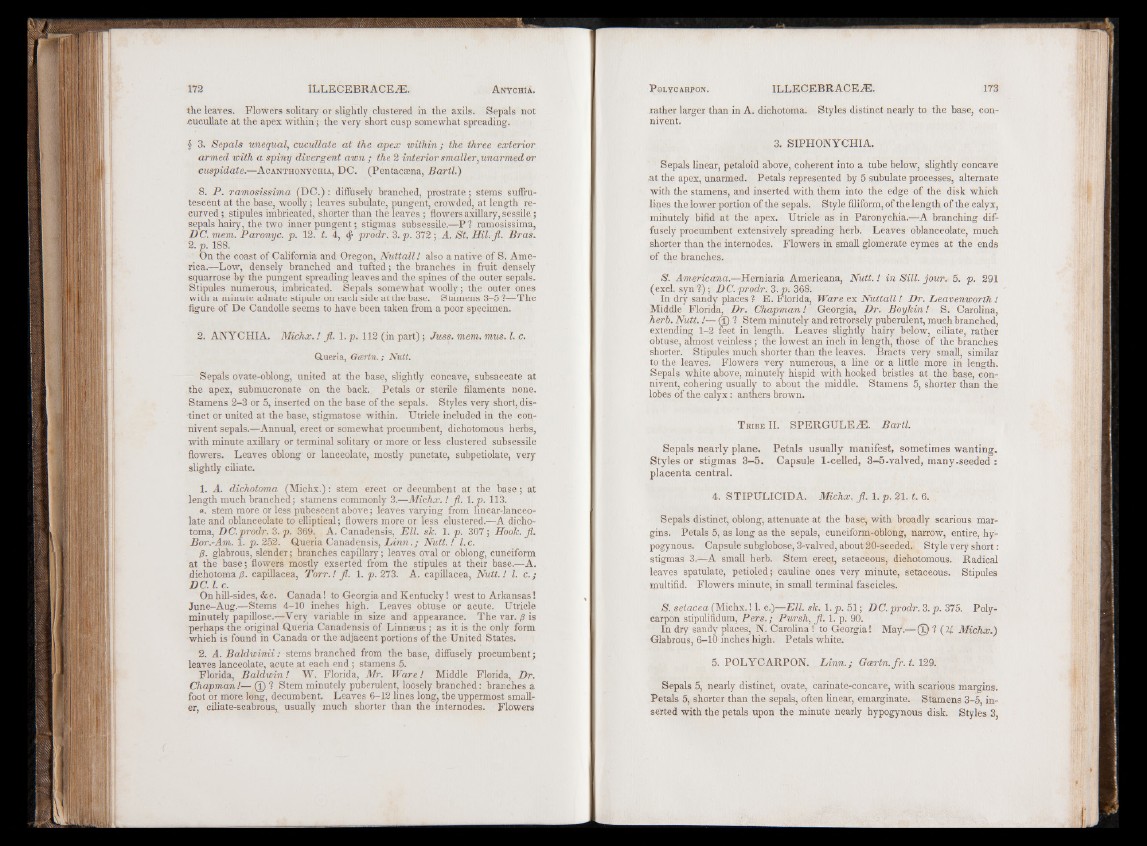
the leaves. Flowers solitary or slightly clustered in the axils. Sepals not
eucullate at the apex within; the very short cusp somewhat spreading.
§ 3. Sepals unequal, eucullate at the apex within; the three exterior
armed with a spiny divergent awn ; the 2 interior smaller, unarmed or
cuspidate.—A canthonychia, DC. (Pentacsena, Bartl.)
8. P. ramosissima (D C .): diffusely branched, prostrate; stems suffru-
tescent at the base, woolly; leaves subulate, pungent, crowded, at length recurved
;_ stipules imbricated, shorter than the leaves ; flowers axillary, sessile;
sepals hairy, the two inner pungent; stigmas subsessile.—P ? ramosissima,
DC. mem. Paronyc. p. 12. t. 4, <£ prodr. 3. p. 372; A. St. Hil.Jl. Bras.
2. p. 188.
On the coast of California and Oregon, Nuttall! also a native of S. America.—
Low, densely branched and tufted; the branches in fruit densely
squarrose by the pungent spreading leaves and the spines of the outer sepals.
Stipules numerous, imbricated. Sepals somewhat woolly; the outer ones
with a minute adnate stipule on each side at the base. Stamens 3-5?—The
figure of De Candolle seems to have been taken from a poor specimen.
2. ANYCHIA. Miehx.! jl. 1. p. 112 (in part); Juss. mem. mus. 1. c.
dueria, Ocertn.; Nutt.
Sepals ovate-oblong, united at the base, slightly concave, subsaccate at
the apex, submucronate on the back. Petals or sterile filaments none.
Stamens 2-3 or 5, inserted on the base of the sepals. Styles very short, distinct
or united at the base, stigmatose within. Utricle included in the con-
nivent sepals.—Annual, erect or somewhat procumbent, dichotomous herbs,
with minute axillary or terminal solitary or more or less clustered subsessile
flowers. Leaves oblong or lanceolate, mostly punctate, subpetiolate, very
slightly eiliate. 1 2
1. A. dichotoma (Miehx.): stem erect or decumbent at the base; at
length much branched; stamens commonly 3.—Miehx. ! fl. 1. p. 113.
a. stem more or less pubescent above; leaves varying from linear-lanceolate
and oblanceolate to elliptical; flowers more or less clustered.—A dichotoma,
DC.prodr. 3. p. 369. A. Canadensis, Ell. sic. 1. p. 307; Hook. jl.
Bor.-Am. 1. p. 252. dueria Canadensis, L in n .; Nutt. | l.c.
0. glabrous, slender; branches capillary; leaves oval or oblong, cuneiform
at the base; flowers mostly exserted from the stipules at their base.—A.
dichotoma/?. capillacea, Torr.l jl. 1. p. 273. A. capillacea, Nutt.! 1. c.;
D C .lc .
On hill-sides, &c. Canada! to Georgia and Kentucky! west to Arkansas!
June-Aug.—Stems 4-10 inches high. Leaves obtuse or acute. Utricle
minutely papillose.—Very variable in size and appearance. The var. 0 is
perhaps the original dueria Canadensis of Linnaeus ; as it is the only form
which is found in Canada or the adjacent portions of the United States.
2. A. Baldwinii: stems branched from the base, diffusely procumbent;
leaves lanceolate, acute at each end ; stamens 5.
Florida, Baldwin I W. Florida, Mr. Ware! Middle Florida, Dr.
Chapman !— @ ? Stem minutely puberulent. loosely branched: branches a
foot or more long, decumbent. Leaves 6-12 lines long, the uppermost smaller,
ciliate-scabrous, usually much shorter than the internodes. Flowers
rather larger than in A. dichotoma. Styles distinct nearly to the base, con-
nivent.
3. SIPHONYCHIA.
Sepals linear, petaloid above, coherent into a tube below, slightly concave
at the apex, unarmed. Petals represented by 5 subulate processes, alternate
with the stamens, and inserted with them into the edge of the disk which
lines the lower portion of the sepals. Style filiform, of the length of the calyx,
minutely bifid at the apex. Utricle as in Paronychia.—A branching diffusely
procumbent extensively spreading herb. Leaves oblanceolate, much
shorter than the intemodes. Flowers in small glomerate cymes at the ends
of the branches.
S. Americana.—Herniaria Americana, Nu tt.! in Sill. jour. 5. p. 291
(excl. syn ?); DC. prodr. 3.jp. 368.
In dry sandy places? E. Florida, Ware ex N u tta ll! Dr. Leavenworth !
Middle Florida, Dr. Chapman! Georgia, Dr. B o yk in ! S. Carolina,
herb. Nutt. !— ? Stem minutely andretrorsely puberulent, much branched,
extending 1-2 feet in length. Leaves slightly hairy below, eiliate,. rather
obtuse, almost veinless ; the lowest an inch in length, those of the branches
shorter. Stipules much shorter than the leaves. Bracts very small, similar
to the leaves. Flowers very numerous, a line or a little more in length.
Sepals white above, minutely hispid with hooked bristles at the base, con-
nivent, cohering usually to about the middle. Stamens 5, shorter than the
lobes of the calyx: anthers brown.
T ribe II. SPERGULEiE. Bartl.
Sepals nearly plane. Petals usually manifest, sometimes wanting.
Styles or stigmas 3 -5 . Capsule 1-celled, 3-5-valved, many-seeded :
placenta central.
4. STIPULICIDA. Miehx. fl. 1. p. 21. t. 6.
Sepals distinct, oblong, attenuate at the base, with broadly scarious margins.
Petals 5, as long as the sepals, cuneiform-oblong, narrow, entire, hy-
pogynous. Capsule subglobose, 3-valved, about 20-seeded. Style very short:
stigmas 3.—A small herb. Stem erect, setaceous, dichotomous. Radical
leaves spatulate, petioled; cauline ones very minute, setaceous. Stipules
multifid. Flowers minute, in small terminal fascicles.
& setacea (Miehx.! 1. c.)—Ell. sk. 1. p. 51; DC. prodr. 3. p. 375. Polycarpon
stipulifidum, Pers.; Pursh, jl. 1. p. 90.
In dry sandy places, N. Carolina ! to Georgia! May.—(T) ? (If Miehx.)
Glabrous, 6-10 inches high. Petals white.
5. POLYCARPON. Lin n .; Gcertn.fr. t. 129.
Sepals 5, nearly distinct, ovate, carinate-concave, with scarious margins.
Petals 5, shorter than the sepals, often linear, emarginate. Stamens 3- 5, inserted
with the petals upon the minute nearly hypogynous disk. Styles 3,